System Dynamics Model and Simulation of Employee Work-Family Conflict in the Construction Industry
Abstract
:1. Introduction
2. Literature Review
2.1. Work-Family Conflict
2.2. The Antecedents of WFC
2.3. The Outcome Variables of WFC
2.4. Research into WFC in the Field of Construction Engineering
3. System Dynamics Model of the Evolution of Employee WFC in the Construction Industry
3.1. Model Framework and Basic Hypothesis and Context
3.1.1. Establishment of Model Framework
3.1.2. Basic Hypothesis and Context
3.2. WFC Evolution Causal Model
- Family Involvement → FIWC → Job Satisfaction Increment → Job Satisfaction → Job Performance → Job Pressure → WIFC → Family Satisfaction Increment → Family Satisfaction → Family Involvement.
- Family Pressure → FIWC → Job Satisfaction Increment → Job Satisfaction → Job Performance → Job Pressure → WIFC → Family Satisfaction Increment → Family Satisfaction → Family Performance → Family Pressure.
- Job Pressure → WIFC → Family Satisfaction Increment → Family Satisfaction → Family Performance → Family Pressure → FIWC → Job Satisfaction Increment → Job Satisfaction → Job Performance → Job Pressure.
- Job Involvement → WIFC → Family Satisfaction Increment → Family Satisfaction → Family Performance → Family Pressure → FIWC → Job Satisfaction Increment → Job Satisfaction → Job Involvement, etc.
3.3. System Flow Diagram of the Construction Industry Employees WFC Evolution
4. Model Simulation and Result Analysis
4.1. Simulation Results under Given Parameters
4.2. Application Analysis of the Simulation Results
5. Conclusions
Acknowledgments
Author Contributions
Conflicts of Interest
References
- Carlson, D.S. Construction and initial validation of a multidimensional measure of work-family conflict. J. Vocat. Behav. 2000, 56, 249–276. [Google Scholar] [CrossRef]
- Bruck, C.S.; Allen, T.D.; Spector, P. The relation between work-family conflict and job satisfaction: A finer-grained analysis. J. Vocat. Behav. 2002, 60, 336–353. [Google Scholar] [CrossRef]
- Kalliath, P.; Kalliath, T. Does job satisfaction mediate the relationship between work-family conflict and psychological strain? A study of Australian social workers. Asia Pac. J. Work Dev. 2013, 23, 91–105. [Google Scholar] [CrossRef]
- Amstad, F.T.; Meier, L.L.; Fasel, U.; Elfering, A.; Semmer, N.K. A meta-analysis of work-family conflict and various outcomes with a special emphasis on cross-domain versus matching-domain relations. J. Occup. Health Psychol. 2011, 16, 151–169. [Google Scholar] [CrossRef] [PubMed]
- Parasuraman, S.; Greenhaus, J.H.; Granrose, C.S. Role stressors, social support and well-being among two-career couples. J. Organ. Behav. 1992, 13, 339–356. [Google Scholar] [CrossRef]
- Carlson, D.S.; Perrewé, P.L. The role of social support in the stressor-strain relationship: An examination of work-family conflict. J. Manag. 1999, 25, 513–540. [Google Scholar] [CrossRef]
- Shockley, K.M.; Singla, N. Reconsidering work-family interactions and satisfaction: A meta-analysis. J. Manag. 2011, 37, 861–886. [Google Scholar] [CrossRef]
- Goodstein, J.D. Institutional pressures and strategic responsiveness: Employer involvement in work-family issues. Acad. Manag. J. 1994, 37, 350–382. [Google Scholar] [CrossRef]
- Jennings, J.E.; McDougald, M.S. Work-family interface experiences and coping strategies: Implications for entrepreneurship research and practice. Acad. Manag. Rev. 2007, 32, 747–760. [Google Scholar] [CrossRef]
- Edwards, J.R.; Rothbard, N.P. Mechanisms linking work and family: Clarifying the relationship between work and family constructs. Acad. Manag. Rev. 2000, 25, 178–199. [Google Scholar]
- Aryee, S.; Srinivas, E.S.; Tan, H.H. Rhythms of life: Antecedents and outcomes of work-family balance in employed parents. J. Appl. Psychol. 2005, 90, 132–146. [Google Scholar] [CrossRef] [PubMed]
- Taylor, B.L.; Del Campo, R.G.; Blancero, D.M. Work-family conflict/facilitation and the role of workplace supports for U.S. Hispanic professionals. J. Organ. Behav. 2009, 30, 643–664. [Google Scholar] [CrossRef]
- Lingard, H.; Francis, V. The work-life experiences of office and site-based employees in the Australian construction industry. Constr. Manag. Econ. 2004, 22, 991–1002. [Google Scholar] [CrossRef]
- Lingard, H.; Sublet, A. The impact of job and organizational demands on marital of relationship satisfaction and conflict among Australian civil engineers. Constr. Manag. Econ. 2002, 20, 507–521. [Google Scholar] [CrossRef]
- Lingard, H.; Francis, V. Does a supportive work environment moderate the relationship between work-family conflict and burnout among construction professionals? Constr. Manag. Econ. 2006, 24, 185–196. [Google Scholar] [CrossRef]
- Zhang, S.X.; Zhao, F.; Hu, Y.R. Project-based employees’ job characteristics, work-family conflict, and need for recovery relations in construction industry. Ind. Eng. J. 2014, 5, 59–63. (In Chinese) [Google Scholar]
- Michel, J.S.; Kotrba, L.M.; Mitchelson, J.K.; Clark, M.A.; Baltes, B.B. Antecedents of work-family conflict: A meta-analytic review. J. Organ. Behav. 2011, 32, 689–725. [Google Scholar] [CrossRef]
- Lin, Z.; Ju, L.; Chen, L. Work-family conflict studies and Chinese issues: Perspectives, content and design. Manag. World 2013, 9, 154–171. (In Chinese) [Google Scholar]
- Zhou, J.X. Formalism trap of the empirical study of social science under the background of big data. Seeker 2014, 10, 10–16. (In Chinese) [Google Scholar]
- Snow, C.C.; Thomas, J.B. Field research methods in strategic management: Contributions to theory building and testing. J. Manag. Stud. 1994, 31, 457–480. [Google Scholar] [CrossRef]
- Kahn, R.L.; Wolfe, D.M.; Quinn, R.P.; Snoek, J.D.; Rosenthal, R.A. Organizational stress: Studies in role conflict and ambiguity. Adm. Sci. Q. 1964, 10, 125–129. [Google Scholar]
- Greenhaus, J.H.; Beutell, N.J. Sources of conflict between work and family roles. Acad. Manag. Rev. 1985, 10, 76–88. [Google Scholar]
- Gutek, B.A. Rational versus gender role explanations for work-family conflict. J. Appl. Psychol. 1991, 76, 560. [Google Scholar] [CrossRef]
- Frone, M.R.; Russell, M.; Cooper, M.L. Antecedents and outcomes of work-family conflict: Testing a model of the work-family interface. J. Appl. Psychol. 1992, 77, 65–78. [Google Scholar] [CrossRef] [PubMed]
- Netemeyer, R.G. Development and validation of work-family conflict and family-work conflict scales. J. Appl. Psychol. 1996, 81, 400. [Google Scholar] [CrossRef]
- Byron, K. A meta-analytic review of work-family conflict and its antecedents. J. Vocat. Behav. 2005, 67, 169–198. [Google Scholar] [CrossRef]
- Karimi, L.; Nouri, A. Do work demands and resources predict work-to-family conflict and facilitation? A study of Iranian male employees. J. Fam. Econ. Issues 2009, 30, 193–202. [Google Scholar] [CrossRef]
- Lapierre, L.M.; Allen, T.D. Work-supportive family, family-supportive supervision, use of organizational benefits, and problem-focused coping: Implications for work-family conflict and employee well-being. J. Occup. Health Psychol. 2006, 11, 169–181. [Google Scholar] [CrossRef] [PubMed]
- Paustian-Underdahl, S.C.; Halbesleben, J.R.B. Examining the influence of climate, supervisor guidance, and behavioral integrity on work-family conflict: A demands and resources approach. J. Organ. Behav. 2013, 35, 447–463. [Google Scholar] [CrossRef]
- Anderson, S.E.; Coffey, B.S.; Byerly, R.T. Formal organizational initiatives and informal workplace practices: Links to work-family conflict and job-related outcomes. J. Manag. 2002, 28, 787–810. [Google Scholar]
- Gao, Z.H.; Hua, C. Why is it so difficult to balance work and family? Discussion based on the work-family boundary theory. Acta Psychol. Sin. 2014, 4, 552–568. (In Chinese) [Google Scholar]
- Lingard, H.C.; Francis, V.; Turner, M. Work-family enrichment in the Australian construction industry: Implications for job design. Constr. Manag. Econ. 2010, 28, 467–480. [Google Scholar] [CrossRef]
- Galea, C.; Houkes, A.; De Rijk, A. An insider’s point of view: How a system of flexible working hours helps employees tostrike a proper balance between work and personal life. Int. J. Hum. Resour. Manag. 2014, 25, 1090–1111. [Google Scholar] [CrossRef]
- Eby, L.T.; Casper, W.J.; Lockwood, A.; Bordeaux, C.; Brinley, A. Work and family research in IO/OB: Content analysis and review of the literature (1980–2002). J. Vocat. Behav. 2005, 66, 124–197. [Google Scholar] [CrossRef]
- Karatepe, O.M.; Sokmen, A. The effects of work role and family role variables on psychological and behavioral outcomes of frontline employees. Tour. Manag. 2006, 27, 255–268. [Google Scholar] [CrossRef]
- Frone, M.R.; Russell, M.; Cooper, M.L. Relation of work-family conflict to health outcomes: A four-year longitudinal study of employed parents. J. Occup. Organ. Psychol. 1997, 70, 325–335. [Google Scholar] [CrossRef]
- Kan, D.; Yu, X. Occupational stress, work-family conflict and depressive symptoms among Chinese bank employees: The role of psychological capital. Int. J. Environ. Res. Public Health 2016, 13, 134. [Google Scholar] [CrossRef] [PubMed]
- Bakker, A.B.; Demerouti, E.; Dollard, M.F. How job demands affect partners’ experience of exhaustion: Integrating work-family conflict and crossover theory. J. Appl. Psychol. 2008, 93, 901–911. [Google Scholar] [CrossRef] [PubMed]
- Loosemore, M.; Nguyen, B.T.; Denis, N. An investigation into the merits of encouraging conflict in the construction industry. Constr. Manag. Econ. 2000, 18, 447–456. [Google Scholar] [CrossRef]
- Lingard, H.; Turner, M. Improving the health of male, blue collar construction workers: A social ecological perspective. Constr. Manag. Econ. 2015, 33, 18–34. [Google Scholar] [CrossRef]
- Leung, M.; Chan, Y.; Olomolaiye, P. Impact of stress on the performance of construction project managers. J. Constr. Eng. Manag. 2008, 134, 644–652. [Google Scholar] [CrossRef]
- Bowen, P.; Govender, R.; Edwards, P. Structural equation modeling of occupational stress in the construction industry. J. Constr. Eng. Manag. 2014, 140, 758–782. [Google Scholar] [CrossRef]
- Bowen, P.; Edwards, P.; Lingard, H. Workplace stress experienced by construction professionals in South Africa. J. Constr. Eng. Manag. 2013, 139, 393–403. [Google Scholar] [CrossRef]
- Ng, S.T.; Skitmore, R.M.; Tony, K.C.L. Manageability of stress among construction project participants. Eng. Constr. Archit. Manag. 2005, 12, 264–282. [Google Scholar] [CrossRef] [Green Version]
- Turner, M.; Mariani, A. Managing the work-family interface: Experience of construction project managers. Int. J. Manag. Proj. Bus. 2016, 9, 243–258. [Google Scholar] [CrossRef]
- MacKenzie, S. A Close Look at Work and Life Balance/Wellbeing in the Victorian Commercial Building and Construction Sector; Building Industry Consultative Council: Melbourne, Australia, 2008. [Google Scholar]
- Lingard, H.; Francis, V.; Turner, M. The rhythms of project life: A longitudinal analysis of work hours and work-life experiences in construction. Constr. Manag. Econ. 2010, 28, 1085–1098. [Google Scholar] [CrossRef]
- Lingard, H.; Francis, V.; Turner, M. Work-family conflict in construction: Case for a finer-grained analysis. J. Constr. Eng. Manag. 2010, 136, 1196–1206. [Google Scholar] [CrossRef]
- Lingard, H.; Francis, V. The decline of the “traditional” family: Work-life benefits as a means of promoting a diverse workforce in the construction industry of Australia. Constr. Manag. Econ. 2005, 23, 1045–1057. [Google Scholar] [CrossRef]
- Pinto, J.K.; Dawood, S.; Pinto, M.B. Project management and burnout: Implications of the demand-control-support model on project-based work. Int. J. Proj. Manag. 2014, 32, 578–589. [Google Scholar] [CrossRef]
- Zhang, S.X.; Zhao, F. Research of the influencing factors on the job performance of construction project staff. J. Xi’an Univ. Archit. Technol. 2012, 6, 870–875. (In Chinese) [Google Scholar]
- Robalino-López, A.; Mena-Nieto, A.; García-Ramos, J.E. System dynamics modeling for renewable energy and CO2 emissions: A case study of Ecuador. Energy Sustain. Dev. 2014, 20, 11–20. [Google Scholar] [CrossRef]
- Lane, D.C.; Monefeldt, C.; Rosenhead, J.V. Looking in the wrong place for healthcare improvements: A system dynamics study of an accident and emergency department. J. Oper. Res. Soc. 2016, 51, 518–531. [Google Scholar] [CrossRef]
- Li, G.Q. Research on work-family conflict theory models. Soft Sci. 2007, 21, 13–16. (In Chinese) [Google Scholar]
- Chen, Z.W.; Tian, S.Q. The review of work-family conflict biphasic theory. Econ. Manag. 2012, 26, 58–63. (In Chinese) [Google Scholar]
- Daalen, G.V.; Willemsen, T.M.; Sanders, K. Reducing work-family conflict through different sources of social support. J. Vocat. Behav. 2006, 69, 462–476. [Google Scholar] [CrossRef]
- Aryee, S.; Luk, V.; Fields, D. A cross-cultural test of a model of the work-family interface. J. Manag. 1999, 25, 491–511. [Google Scholar] [CrossRef]
- Moen, P.; Kelly, E.; Huang, Q. Work, family and life-course fit: Does control over work time matter? J. Vocat. Behav. 2008, 73, 414–425. [Google Scholar] [CrossRef] [PubMed]
- Liu, J.Y.; Sui, P.L. Work-family conflicts experienced by project managers in the Chinese construction industry. Int. J. Proj. Manag. 2011, 29, 117–128. [Google Scholar] [CrossRef]
- Yang, N.N.; Chen, C.C.; Choi, J.; Zou, Y.M. Sources of work-family conflict: A sino-U.S. comparison of the effects of work and family demands. Acad. Manag. J. 2000, 43, 113–123. [Google Scholar] [CrossRef]
- Zhang, M.; Li, H.; Wei, J.; Yang, B.Y. Cross-over effects or direct effects? The mechanism linking work-family conflict with outcomes. Acta Psychol. Sin. 2011, 43, 573–588. [Google Scholar]
- Yang, Q.; Feng, J.H.; Guo, L. Effect of personal-post matching on workers’ job performance—A mediating role of job satisfaction. J. Xi’an Technol. Univ. 2015, 3, 227–234. (In Chinese) [Google Scholar]
- Luo, C.L. Research literature review on the relationship between work-family enrichment and work-family performance. China Econ. Trade Her. 2015, 28, 70–74. (In Chinese) [Google Scholar]
- Akhtar, Z.; Nadir, H. Job satisfaction and job involvement among private and government bank employees. Indian J. Health Wellbeing 2016, 7, 236–239. [Google Scholar]
- Sukri, S.; Asogan, P.; Waemustafa, W. Factor influencing job involvement in university Malaysia Perlis (UniMAP). Mediterr. J. Soc. Sci. 2015, 6, 157. [Google Scholar]
- Ma, L.; Yao, Y. The relationship between work life quality, job involvement and job performance of new generation employees. Enterp. Econ. 2016, 3, 99–104. (In Chinese) [Google Scholar]
- Thomas, L.T.; Ganster, D.C. Impact of family-supportive work variables on work-family conflict and strain: A control perspective. J. Appl. Psychol. 1995, 80, 6–15. [Google Scholar] [CrossRef]
- Wang, Q.F. System Dynamics; Shanghai University of Finance and Economics Press: Shanghai, China, 2009. (In Chinese) [Google Scholar]

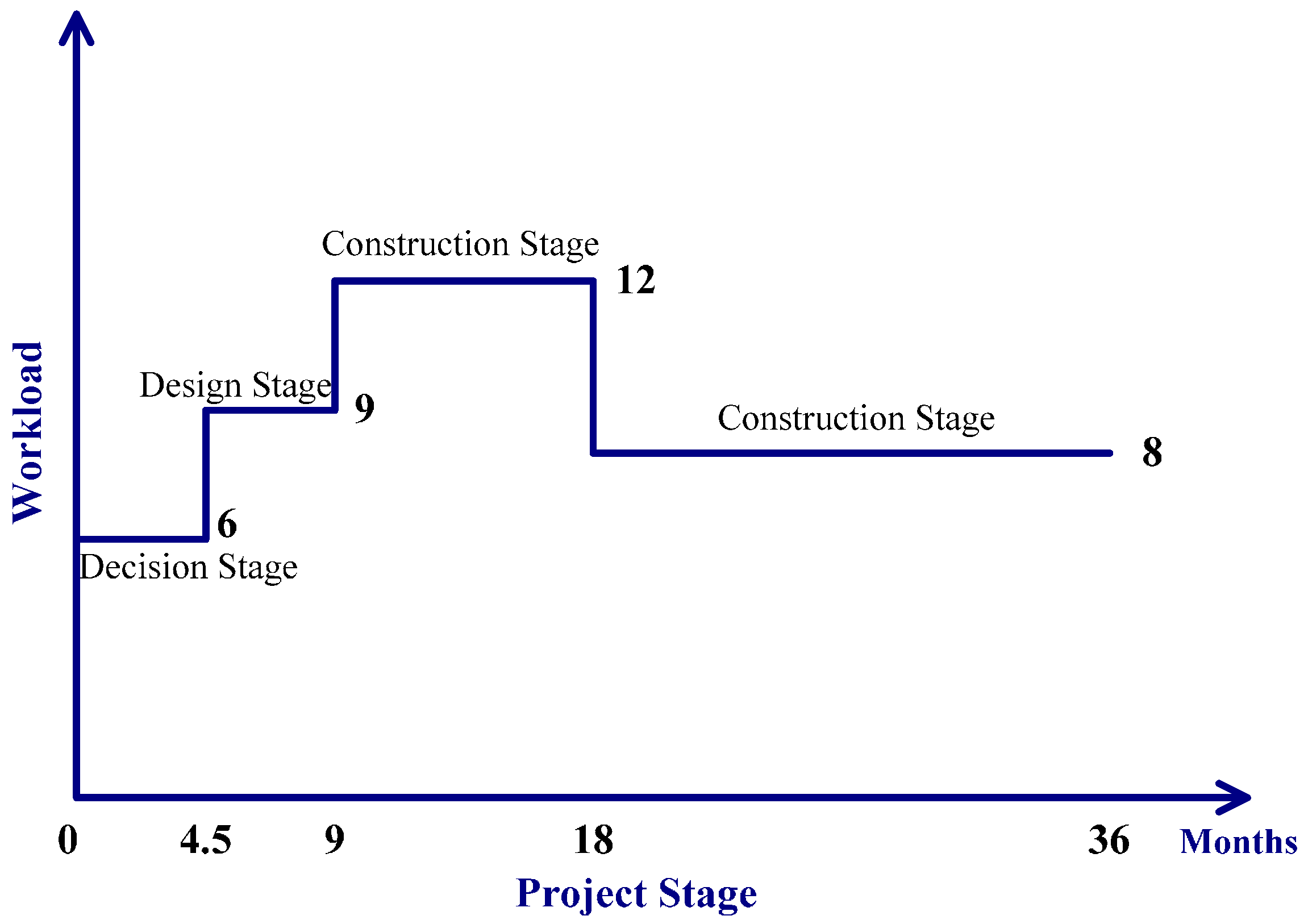
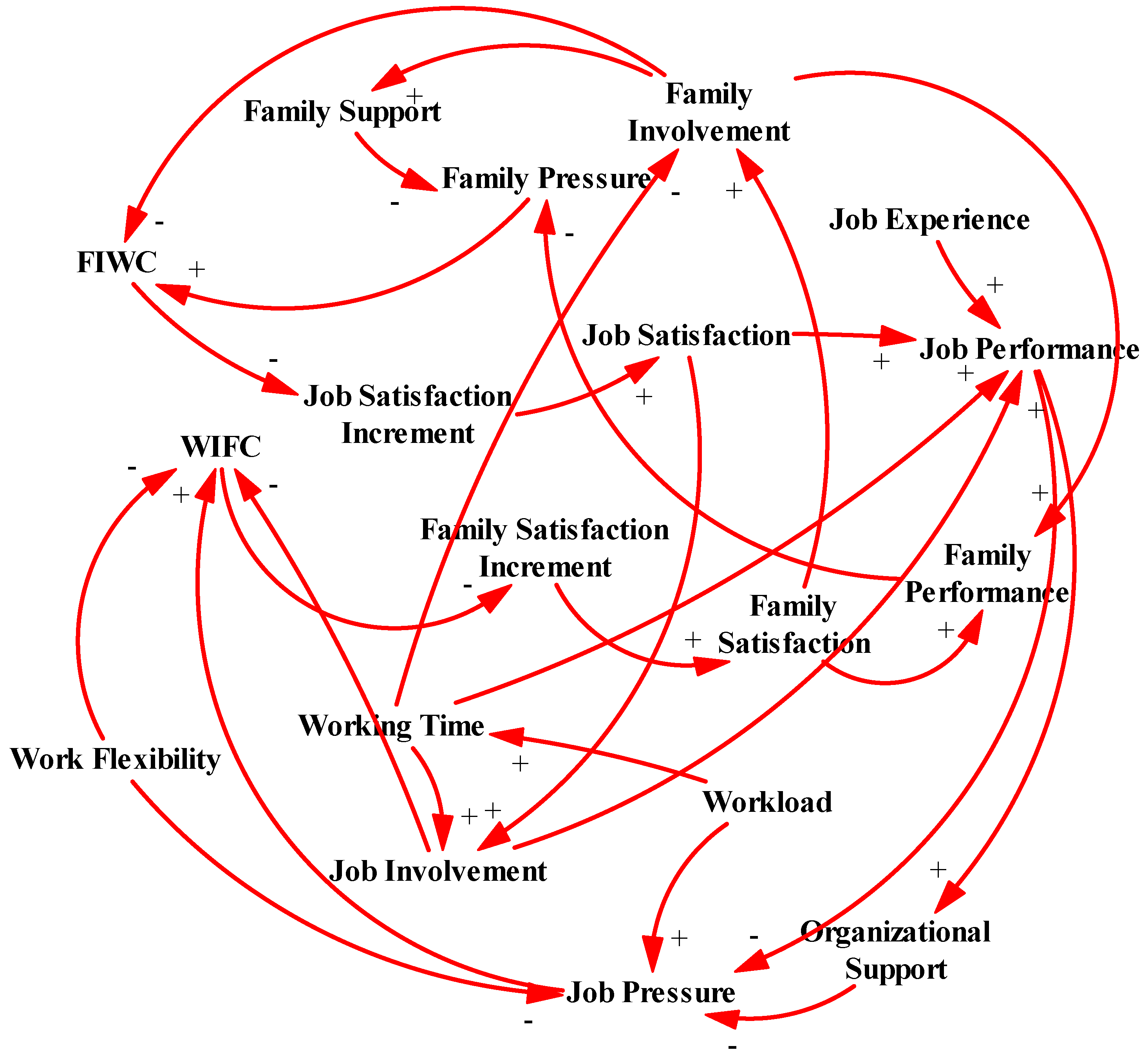
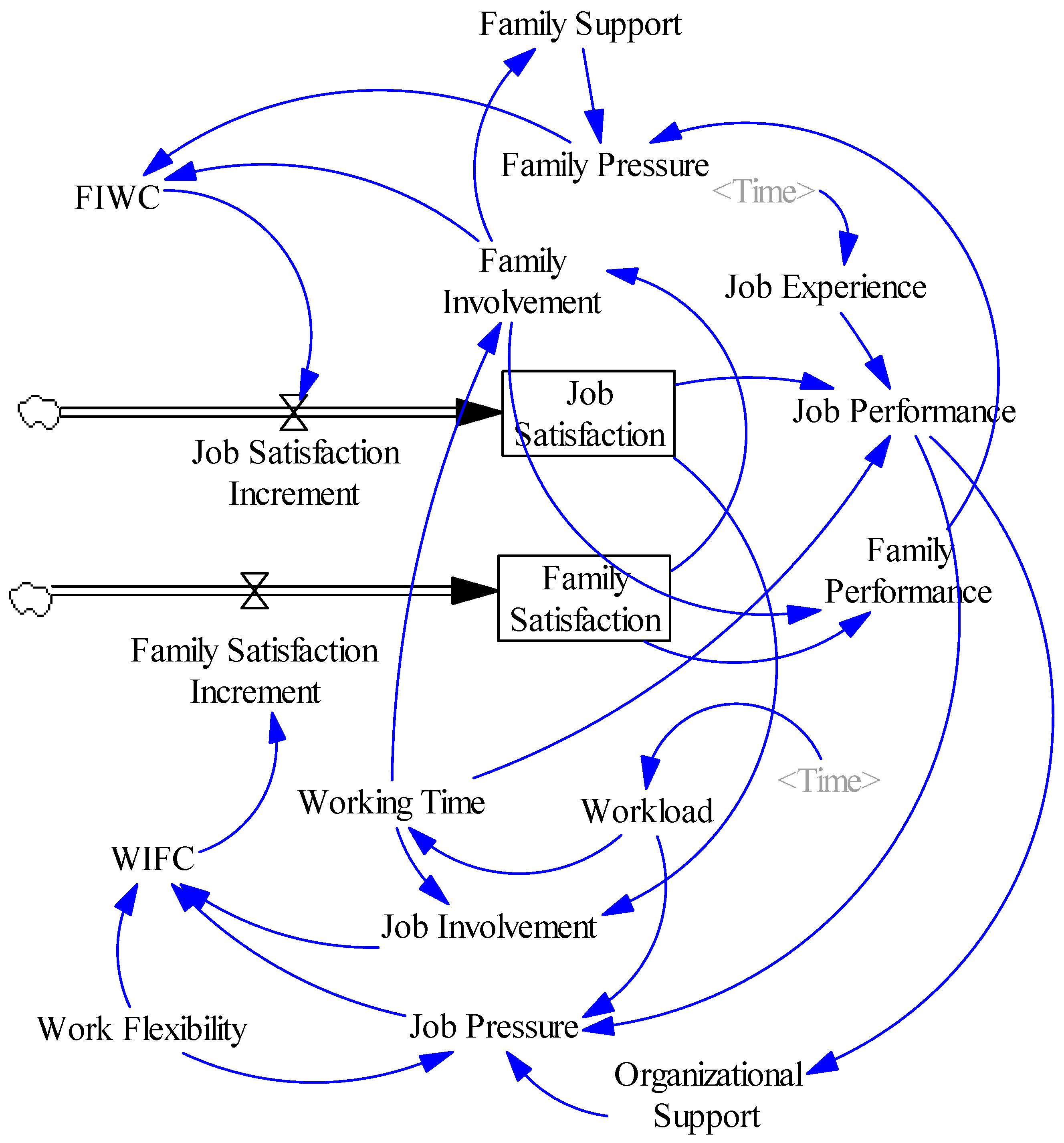


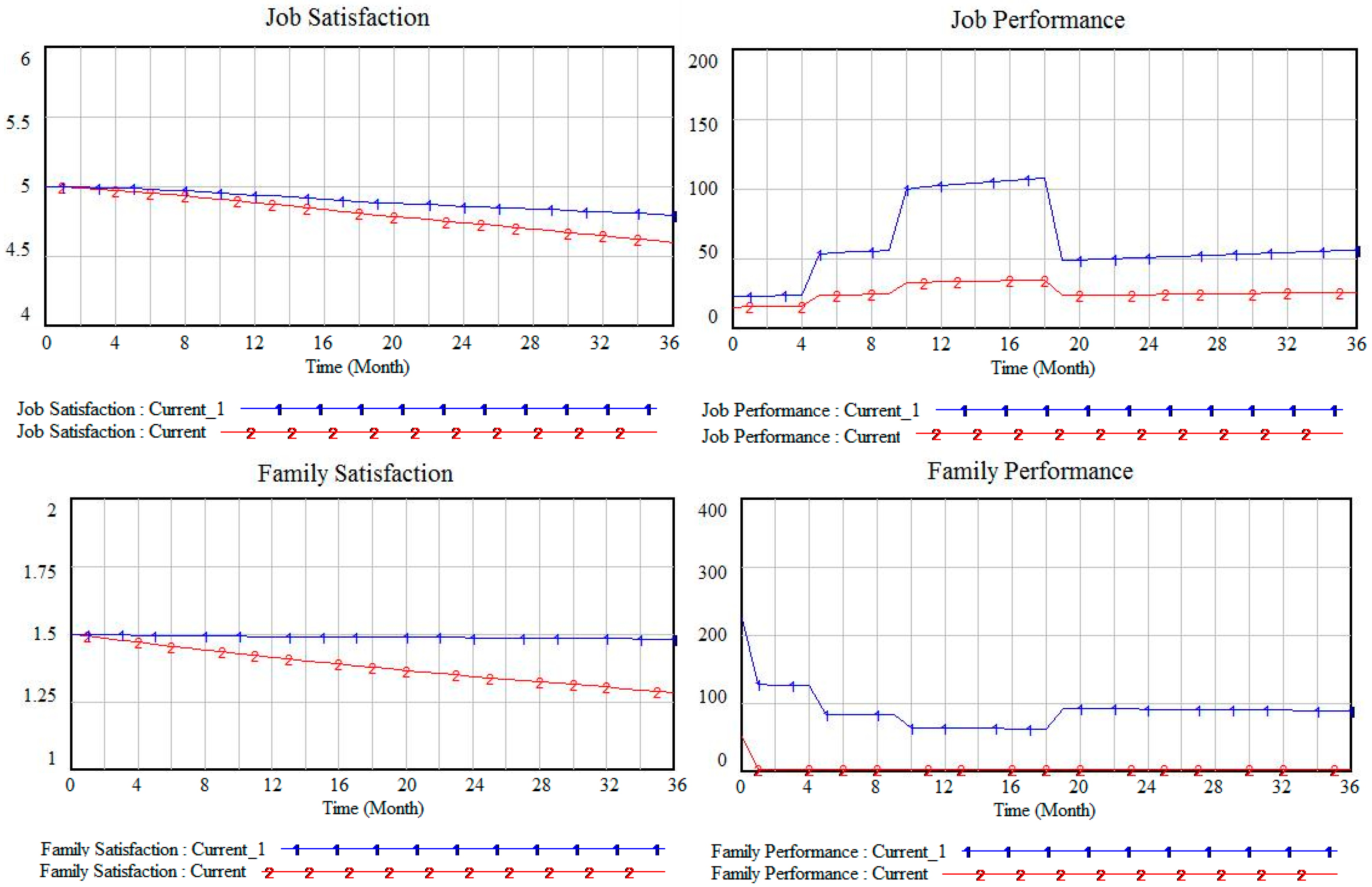
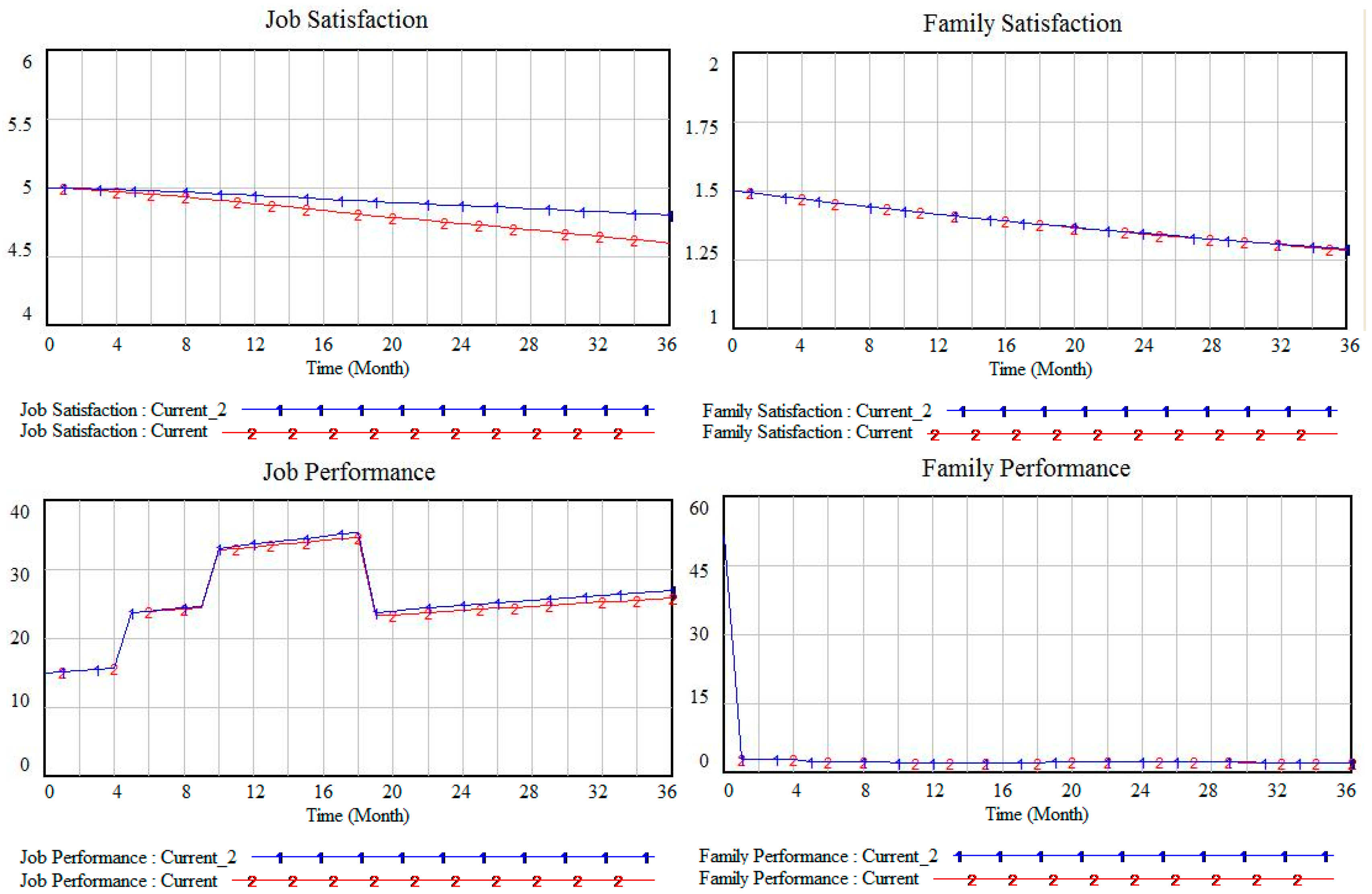
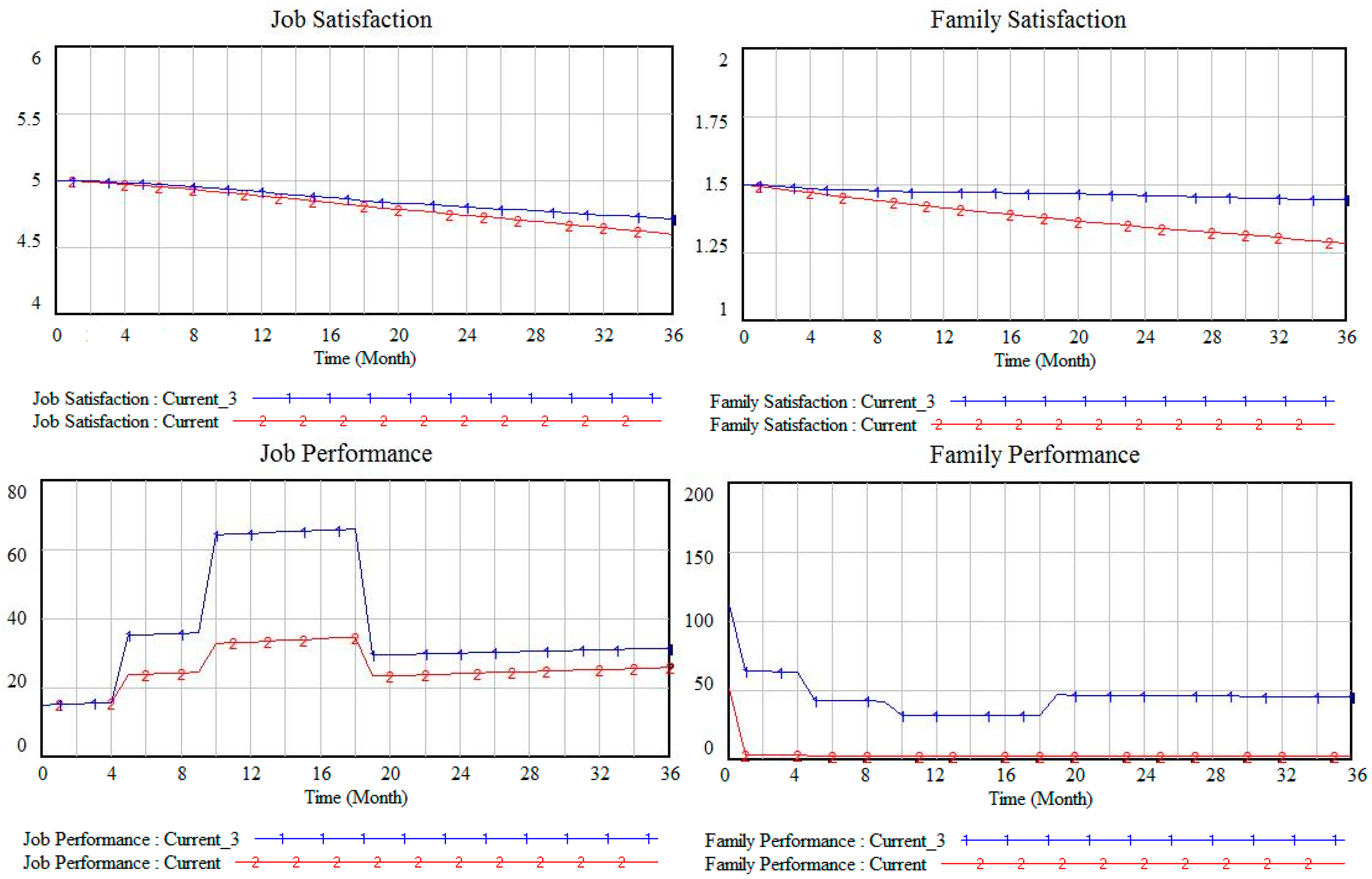
© 2016 by the authors; licensee MDPI, Basel, Switzerland. This article is an open access article distributed under the terms and conditions of the Creative Commons Attribution (CC-BY) license (http://creativecommons.org/licenses/by/4.0/).
Share and Cite
Wu, G.; Duan, K.; Zuo, J.; Yang, J.; Wen, S. System Dynamics Model and Simulation of Employee Work-Family Conflict in the Construction Industry. Int. J. Environ. Res. Public Health 2016, 13, 1059. https://doi.org/10.3390/ijerph13111059
Wu G, Duan K, Zuo J, Yang J, Wen S. System Dynamics Model and Simulation of Employee Work-Family Conflict in the Construction Industry. International Journal of Environmental Research and Public Health. 2016; 13(11):1059. https://doi.org/10.3390/ijerph13111059
Chicago/Turabian StyleWu, Guangdong, Kaifeng Duan, Jian Zuo, Jianlin Yang, and Shiping Wen. 2016. "System Dynamics Model and Simulation of Employee Work-Family Conflict in the Construction Industry" International Journal of Environmental Research and Public Health 13, no. 11: 1059. https://doi.org/10.3390/ijerph13111059





